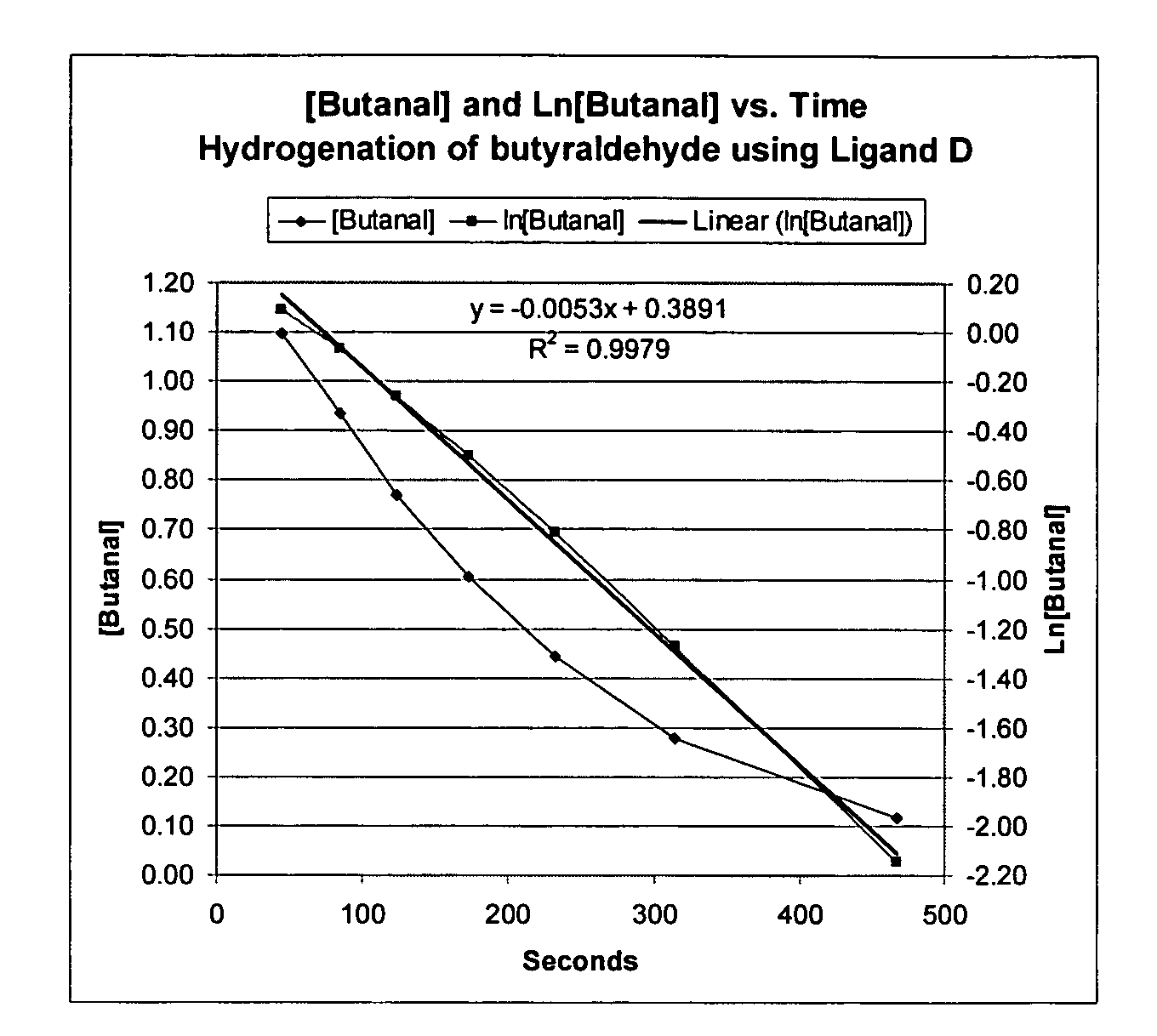Novel tridentate phosphines and method of forming aldehyde hydrogenation catalysts
a hydrogenation catalyst and tridentate phosphine technology, which is applied in the field of aldehyde hydrogenation process to alcohol, can solve the problems of limited utility of these catalysts, low regio- and chemo-selectivity, and the need for very high temperatures and pressures, and/or slow hydrogenation ra
- Summary
- Abstract
- Description
- Claims
- Application Information
AI Technical Summary
Problems solved by technology
Method used
Image
Examples
example 1
Synthesis of Ph2P(CH2)3P(H)Ph
[0024] In a Schlenk flask were placed phenylphosphine (3.3806 g, 30.71 mmol) with THF (60 ml) and chilled to −30° C. in a freezer over 30 minutes. To this solution was added lithium diisopropylamide (16 ml, 32.16 mmol) and the resulting solution was allowed to warm to room temperature while stirring. In a 250 ml Schlenk flask was placed (C6H5)2P(CH2)3Cl (7.9089 g, 30.1 mmol) in 100 ml THF and the solution was cooled to −78° C. The lithium phenylphosphide solution was added to the (C6H5)2P(CH2)3Cl solution at such a rate that the temperature of the solution remained constant at −78° C. After addition, the solution was slowly warmed to room temperature. Degassed DI water (0.2 ml) was added to the dark orange solution. The color changed to yellow-orange. The solvents were removed in vacuo. The resulting gel was dissolved in toluene and filtered through Celite. Toluene was then removed in vacuo, leaving an orange-yellow oil. Yield: 10.0 g (99.1%). 31P{1H} N...
example 2
Synthesis of (C6H5)2P(CH2)3P(C6H5)(CH2)3Cl
[0025] A solution of (C6H5)2P(CH2)3P(H)(C6H5) (10.0 g, 29.7 mmol), tetrahydrofuran (100 ml) and 1-Bromo-3-chloropropane (5.086 g, 32.3 mmol) was prepared in a Schlenk flask and cooled to −78° C. Using a cannula, lithium diisopropylamide (16.6 ml, 33.0 mmol) was added dropwise at a rate such that the temperature was held constant. The resulting solution was warmed to room temperature and stirred for 30 minutes. Degassed, DI water (0.2 ml) was added to quench any unreacted lithium reagents. The solvents were removed in vacuo without heat. The resulting orange gel was stirred in toluene (200 ml) and filtered through a medium fritted glass funnel packed with Celite. The filtrate was then removed in vacuo with a room temperature water bath, leaving an orange oil containing fine solids. The material was again stirred in toluene and filtered through Celite. The solvent was then removed in vacuo with a room temperature water bath to obtain a viscou...
example 3
Synthesis of Ligand A, Ph2P(CH2)3P(Ph)(CH2)3P(Ph)(n-C6H13)
[0026] This reaction was carried out in a glove box. A solution of cyclohexylphenylphosphine (2.023 g 10.41 mmol) and tetrahydrofuran (30 ml) was cooled to −30° C. for 30 minutes. Lithium diisopropylamide (5.6 ml, 11 mmol) was added to the cooled solution and allowed the resulting solution to warm to room temperature with an additional hour of stirring. In a separate flask, (C6H5)2P(CH2)3P(C6H5)(CH2)3Cl (4.3605 g, 10 mmol) was dissolved in 60 ml THF and chilled to −30° C. over 30 minutes. Using a syringe, the lithium cyclohexylphenylphosphide solution was added to the (C6H5)2P(CH2)3P(C6H5)(CH2)3Cl solution at −30° C. This dark orange solution was stirred overnight. Ethanol (0.2 ml) was then added to the solution. The solution turned orange yellow in color. Solvents were removed in vacuo and the residue stirred in toluene and filtered through a medium fritted glass funnel packed with Celite. The filtrate was contained in a Sc...
PUM
| Property | Measurement | Unit |
|---|---|---|
| partial pressure | aaaaa | aaaaa |
| partial pressure | aaaaa | aaaaa |
| partial pressure | aaaaa | aaaaa |
Abstract
Description
Claims
Application Information
 Login to View More
Login to View More - R&D
- Intellectual Property
- Life Sciences
- Materials
- Tech Scout
- Unparalleled Data Quality
- Higher Quality Content
- 60% Fewer Hallucinations
Browse by: Latest US Patents, China's latest patents, Technical Efficacy Thesaurus, Application Domain, Technology Topic, Popular Technical Reports.
© 2025 PatSnap. All rights reserved.Legal|Privacy policy|Modern Slavery Act Transparency Statement|Sitemap|About US| Contact US: help@patsnap.com



